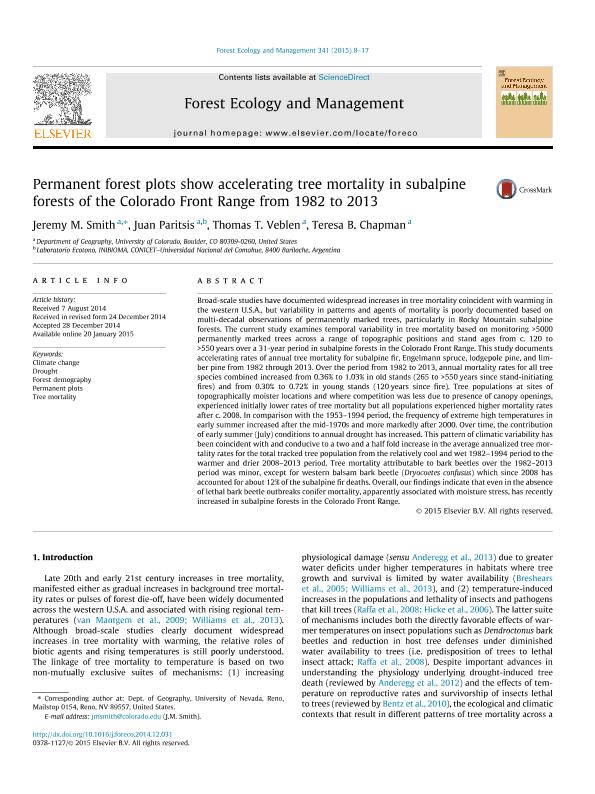Artículo
Permanent forest plots show accelerating tree mortality in subalpine forests of the Colorado Front Range from 1982 to 2013
Fecha de publicación:
04/2015
Editorial:
Elsevier Science
Revista:
Forest Ecology and Management
ISSN:
0378-1127
Idioma:
Inglés
Tipo de recurso:
Artículo publicado
Clasificación temática:
Resumen
Broad-scale studies have documented widespread increases in tree mortality coincident with warming in the western U.S.A., but variability in patterns and agents of mortality is poorly documented based on multi-decadal observations of permanently marked trees, particularly in Rocky Mountain subalpine forests. The current study examines temporal variability in tree mortality based on monitoring >5000 permanently marked trees across a range of topographic positions and stand ages from c. 120 to >550 years over a 31-year period in subalpine forests in the Colorado Front Range. This study documents accelerating rates of annual tree mortality for subalpine fir, Engelmann spruce, lodgepole pine, and limber pine from 1982 through 2013. Over the period from 1982 to 2013, annual mortality rates for all tree species combined increased from 0.36% to 1.03% in old stands (265 to >550 years since stand-initiating fires) and from 0.30% to 0.72% in young stands (120 years since fire). Tree populations at sites of topographically moister locations and where competition was less due to presence of canopy openings, experienced initially lower rates of tree mortality but all populations experienced higher mortality rates after c. 2008. In comparison with the 1953?1994 period, the frequency of extreme high temperatures in early summer increased after the mid-1970s and more markedly after 2000. Over time, the contribution of early summer (July) conditions to annual drought has increased. This pattern of climatic variability has been coincident with and conducive to a two and a half fold increase in the average annualized tree mortality rates for the total tracked tree population from the relatively cool and wet 1982?1994 period to the warmer and drier 2008?2013 period. Tree mortality attributable to bark beetles over the 1982?2013 period was minor, except for western balsam bark beetle (Dryocoetes confusus) which since 2008 has accounted for about 12% of the subalpine fir deaths. Overall, our findings indicate that even in the absence of lethal bark beetle outbreaks conifer mortality, apparently associated with moisture stress, has recently increased in subalpine forests in the Colorado Front Range.
Palabras clave:
Climate Change
,
Drought
,
Tree Demography
,
Permanent Plots
,
Tree Mortality
Archivos asociados
Licencia
Identificadores
Colecciones
Articulos(INIBIOMA)
Articulos de INST. DE INVEST.EN BIODIVERSIDAD Y MEDIOAMBIENTE
Articulos de INST. DE INVEST.EN BIODIVERSIDAD Y MEDIOAMBIENTE
Citación
Smith, Jeremy M.; Paritsis, Juan; Veblen, Thomas T.; Chapman, Teresa B.; Permanent forest plots show accelerating tree mortality in subalpine forests of the Colorado Front Range from 1982 to 2013; Elsevier Science; Forest Ecology and Management; 341; 4-2015; 8-17
Compartir
Altmétricas




